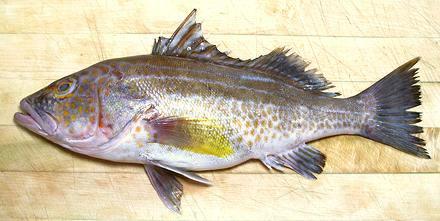 [Family Serranidae (Sea Basses) Paralabrax sp.]
[Family Serranidae (Sea Basses) Paralabrax sp.]
Several varieties of Sand Bass are found in Southern California waters: Goldspotted (P. auroguttatus), Barred (P.nebulifer), Spotted (P. maculatofasciatus). The Goldspotted is the only one much seen in markets here in Los Angeles, but the others are about the same as far as cooking is concerned. The Goldspotted is fished mainly in the Gulf of California. It can grow to 28 inches and 6 pounds, but the photo specimen, caught wild in Mexican waters, was 15 inches long and weighed a 1 pound 10 ounces. I have purchased them up to a little over 4 pounds.
More on Bass Family.
The flesh of Sand Bass is mild and light, and contains very little oil. The darker layer right under the skin has an only slightly stronger taste but not at all distracting. The only negative for this fish is the limited number of ways it can be cooked.
The flesh is very tender and doesn't hold up well to wet cooking. It tends to break apart at random points rather than neatly along the flake margins. Whole fish are not so good for steaming or baking because the skin becomes very soft and may not look good. It is best to either dust fillets with rice flour and pan fry them, or cut them in half crosswise and poach them gently.
Scales: This fish is completely covered with small scales that have fairly good adhesion. They aren't hard to scrape off but do fly around a bit. Some will capsize rather than scrape off so some patches will have to be shaved off with the sharp edge of the knife.
Cleaning: Cleaning presents no unusual problems, but you will want to use kitchen shears to cut the throat from the head and cut out the gill arches, which are rather hard to pull. The swim bladder and other membranes don't pull easily, so a sturdy pair of long nose pliers is very helpful.
Fillet: Sand Bass is an easy fish to fillet because it has a very coherent bone structure. It's best to start by removing the head, then cut through the skin to outline the fillet top and bottom. Working from head to tail cut down to the backbone, then go over the backbone at the tail and work forward until you get to the body cavity. Cut the ribs from the backbone with kitchen shears and pull them from the fillet with long nose pliers - they pull easily taking little flesh. There are nasty centerline pin bones for the length of the body cavity. Feel for them and pull them out straight forward with the pliers.
Yield: This is a big headed fish so yield is not spectacular, but better than many fish. A 1 pound 10 ounce fish yielded 11-3/4 ounces of skin-on fillet (45%) and 10-3/4 ounces skin-off (41%). With the thin skirt removed it was 9-5/8 ounces (37%). A larger fish will yield a little higher.
Skin: The skin has no strong or "off" taste, but it shrinks sharply when heated - then becomes very soft. When frying skin-on it must be well coated with rice flour or some other flour or it will stick to the pan and make a mess. The skin is rather tough, so can be easily removed easily using the standard long knife and cutting board Method.
Stock: The heads, bones and fins, simmered very gently for no more than 40 minutes, make a serviceable stock with an interesting flavor. Not "stock lite", but quite usable. Remove all oil using your gravy separator. For details see our recipe Making Fish Stock.
sf_basssz 060704 r 130922 - www.clovegarden.com